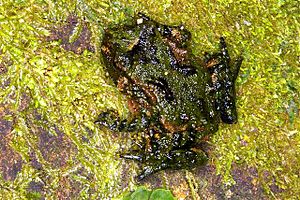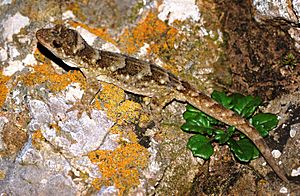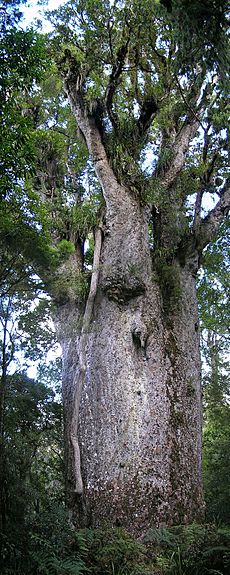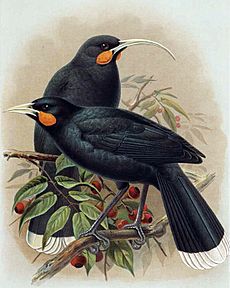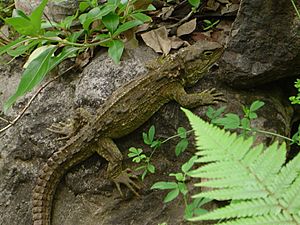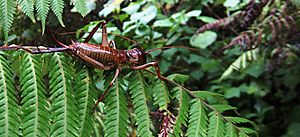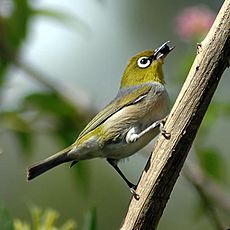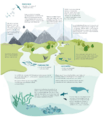Biodiversity of New Zealand facts for kids
New Zealand is a large island country in the Pacific Ocean. It has a very special and diverse collection of living things, known as its biodiversity. Over millions of years, the plants and animals here have changed and developed in unique ways. Many species found in New Zealand are endemic, meaning they live nowhere else in the world!
Long ago, about 65 million years ago, a huge event caused many animals to disappear, like the dinosaurs. New Zealand's ancient animals are not fully known. But we do know that for millions of years before people arrived, the islands had no land mammals, except for bats and seals. Instead, the main land animals were insects and birds. Later, around the 14th century, humans started to arrive. They brought new animals with them, including many land mammals.
Today, New Zealand has a special plan called the Biodiversity Action Plan. This plan helps protect the many threatened plants and animals that call New Zealand home.
Contents
How New Zealand's Life Evolved
Millions of years ago, all the continents were joined together in a huge landmass called Gondwana. When Gondwana broke apart, New Zealand (which was part of a larger continent called Zealandia) started to move away from Antarctica about 85 million years ago. It has been moving north ever since.
About 23 million years ago, most of New Zealand was under the sea. Some scientists think only small islands were left above water. Today, about 93% of the Zealandia continent is still underwater!
Some of New Zealand's plants and animals are related to those found in other parts of the old Gondwana. These include ancient plants like podocarps and southern beech trees. There are also unique insects, unusual frogs, the tuatara, and some birds. It's possible some early mammals were also part of this ancient group. However, recent studies show that even some "Gondwanan" plants, like the southern beeches, arrived in New Zealand after it separated from Gondwana.
After New Zealand broke away, new species arrived mainly by flying or floating across the sea. Most of these came from Australia. They brought many of New Zealand's birds and bats. Some arrived so long ago that they look very different from their Australian relatives now. For example, the unique short-tailed bats were a mystery until their fossils were found in Australia. Other animals, like certain parakeets, skinks, and geckos, seem to have come from places like New Caledonia.
New Zealand's Unique Plants
New Zealand's long history, climate, and geology have created many different types of plant life. The main types of forests are dominated by either podocarps or southern beech trees.
Podocarps are ancient evergreen trees that haven't changed much in 190 million years. They form dense forests with many other trees and shrubs underneath. Southern beech forests are simpler, with four types of beech trees making up most of the forest.
In the north of New Zealand, the forests were once filled with giant kauri trees. These trees are among the largest in the world! Early European settlers quickly realized how valuable their timber was, and most kauri trees were cut down.
Other plant areas include grasslands with tall tussock grasses, especially in mountain areas. There are also low shrublands between grasslands and forests. These are often filled with woody daisy plants that can grow up to 3 meters tall.
Besides land plants, New Zealand has many types of algae. Large southern bull kelp can be found along the coasts of the main islands and other smaller islands.
New Zealand's Unique Animals
Until recently, scientists thought that no land mammals (except bats and seals) lived in New Zealand before humans arrived. But in 2006, a fossil of an extinct land mammal was found in Otago. It was 16-19 million years old! This discovery changed our understanding of New Zealand's past. We don't know when or why land mammals disappeared from New Zealand, but none were present for millions of years before humans.
Bats
New Zealand's short-tailed bats are very special. They are unique because they often search for food on the ground, unlike most bats. This was once thought to be because there were no other land mammals to compete with. However, fossils show that their ground-foraging habit evolved even when other land mammals were around in Australia. Some plants in New Zealand have even evolved to be pollinated by these bats on the ground! The long-tailed bat is also found here and is more common.
Birds
Birds are the most important part of New Zealand's native animal life. It's not clear if many New Zealand birds came from the ancient Gondwana landmass. Even the flightless kiwis and moas seem to have arrived after New Zealand separated from Antarctica. However, recent studies suggest that New Zealand wrens are very ancient birds, possibly descendants from Gondwana.
Because there were no land mammals, birds in New Zealand took on roles usually filled by mammals in other places.
- The moas were large, plant-eating birds. There were eleven different types!
- The giant Haast's eagle hunted the moa.
Both the moa and the Haast's eagle disappeared soon after humans arrived around 1300 CE. It seems humans hunted the moa, and then the eagles had no food.
New Zealand's famous kiwis are small birds that search for food in the leaf litter. The mysterious adzebill was a bird that ate everything. The Callaeidae (wattlebirds) are a family of birds found only in New Zealand. Many other New Zealand birds are related to Australian birds, like the New Zealand pigeon and falcon. About 71% of New Zealand's 245 native bird species were found nowhere else.
Reptiles and Amphibians
New Zealand has no agamas or iguanas. Its lizards are geckos and skinks, which arrived at different times. Fossils show that millions of years ago, New Zealand had many different reptiles, including crocodiles and turtles!
The tuatara is New Zealand's largest living reptile, growing up to 60 cm (23.6 inches). It is the only surviving member of a very ancient group of reptiles called Sphenodontia.
Frogs usually don't live on islands far from continents because they can't handle saltwater. But New Zealand has a few unique frogs that are thought to be descendants of ancestors from Gondwana. New Zealand's few freshwater fish also came from species that travel between fresh and saltwater.
Insects and Other Invertebrates
New Zealand's land insects and other invertebrates (animals without backbones) are also very special. Many species of snails live here. Many insects have become very large and often can't fly, like some grasshoppers and beetles. However, there are fewer than 12 types of ants.
The most famous New Zealand insects are the wētā. These are ground-living relatives of crickets that can grow to enormous sizes! Many unique marine invertebrates, especially sea snails, have also evolved in the waters around New Zealand.
Endemic Species
New Zealand has a very high number of endemic species. This means they are found only in New Zealand and nowhere else!
- 80% of all native plants
- 70% of all native land and freshwater birds
- All native bats
- All native amphibians (frogs)
- All native reptiles (lizards and tuatara)
- 90% of freshwater fish
- 90% of insects and molluscs (including 75% of marine molluscs)
New Zealand also has two unique types of dolphins: Hector's dolphin and its close relative, Maui's dolphin.
Human Impact
When humans arrived in New Zealand, they greatly changed the natural environment. This caused a big threat to native species and led to many extinctions. This happened because many New Zealand species had evolved without any land predators for millions of years. They didn't know how to protect themselves from new dangers.
Humans brought many new species with them, sometimes on purpose, sometimes by accident.
- The first settlers (the ancestors of the Māori) arrived around 1300 CE. They brought the Polynesian rat. This led to the extinction of small, defenseless ground-nesting birds.
- Later, the Māori hunted many larger species for food, like the moa, adzebill, and large ducks. The Haast's eagle also disappeared because its main food source (moa) was gone.
- When European settlers arrived, they brought even more new mammals, like domestic cats, stoats, weasels, rats, and possums. They also brought plant-eaters like deer and wallabies, which harm native plants.
In total, over 50% of New Zealand's bird species are now extinct. Also gone are a bat species, several frogs (only four types remain), a freshwater fish, and some skinks and geckos.
Sometimes, when native animals disappeared, new species from Australia naturally moved in. For example, the silvereye bird arrived in the 1800s and now lives in new habitats created by humans. The black swan also came back to New Zealand, as its extinct relative was once here. Even birds like the pūkeko and swamp harrier have arrived, filling roles similar to those of extinct New Zealand birds like the takahē and Eyles's harrier.
Protecting Biodiversity
The New Zealand government, through the New Zealand Department of Conservation, works hard to protect its unique living heritage. They have become experts at "island restoration." This means they clear introduced animals like goats, cats, and rats from offshore islands. Then, they reintroduce native species that can thrive without these predators and competitors. Cuvier Island is one of the longest-running projects, but other islands like Tiritiri Matangi are also used.
Conservation efforts are not just on islands. Several "ecological islands" have been created on the New Zealand mainland. These areas are protected by special fences that keep out pests.
Images for kids


